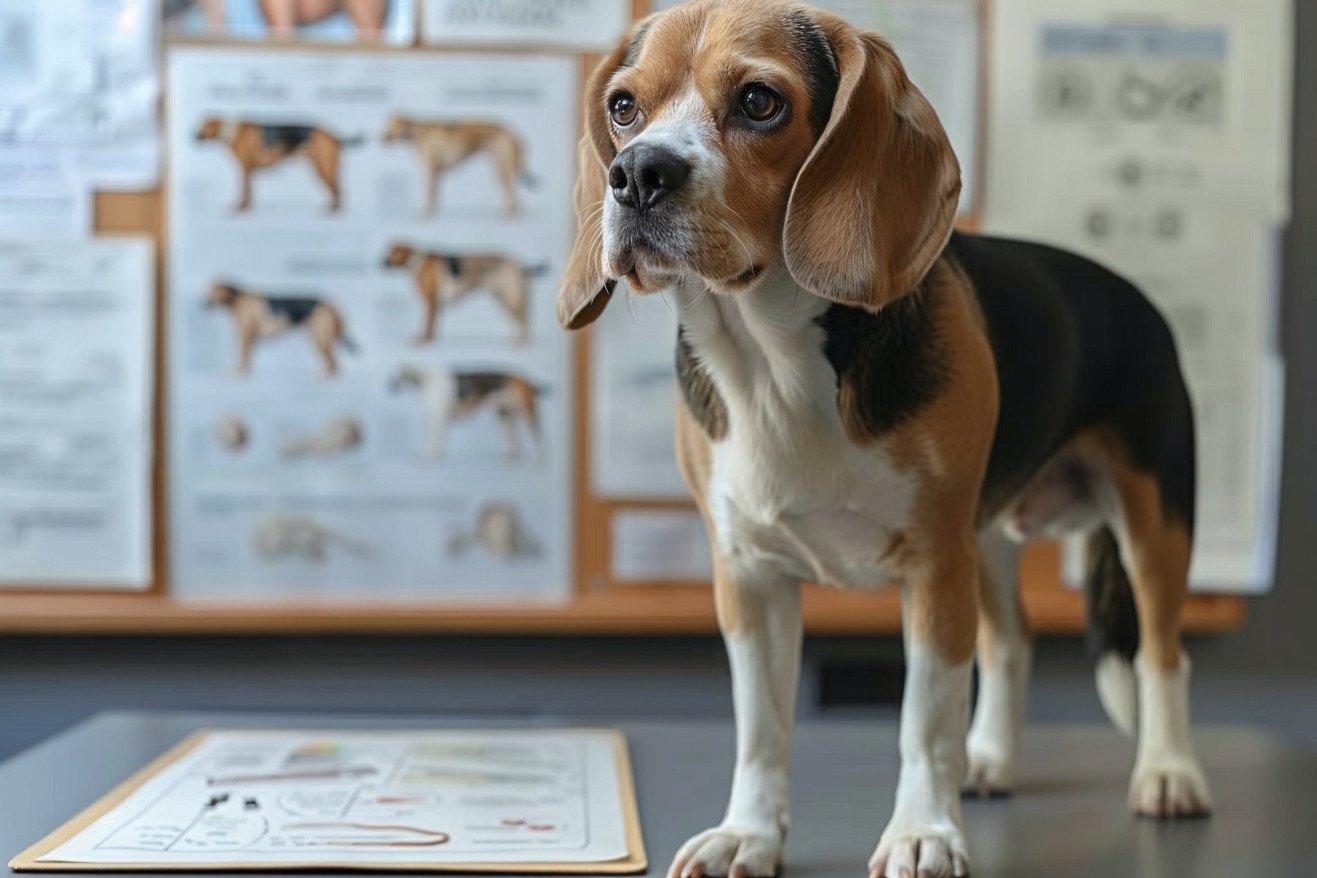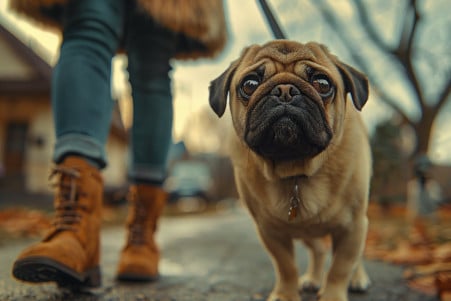Do Dogs Have Knees? Understanding Canine Leg Anatomy
11 March 2024 • Updated 10 March 2024

If you’ve ever watched your dog run around and wondered about the specifics of their leg anatomy, you’re not alone. And yes, dogs do have knees on their hind legs. Just like in humans, the knee joint includes a patella (kneecap) and is important for a dog’s ability to move, enabling the flexion and extension needed for walking and running.
This article will take a deep dive into the anatomy of the canine knee, drawing on a range of research and sources from veterinary science, comparative anatomy, and evolutionary biology.
It will also look at how research on canine anatomy can help us understand the most common knee-related problems dogs face, as well as the causes and most recent treatments for these issues. Through this interdisciplinary approach, you’ll come away with a full understanding of how important knees are to a dog’s life and health.
Do dogs have knees?
Anatomy of the Dog Knee
When examining the anatomy of the dog knee, one of the most important things to note is the stifle joint, which is a complex system of bones, ligaments, and tendons.
According to Ortho Dog, the stifle joint, or knee, is where the femur (thigh bone) meets the tibia and fibula (lower leg bones) and also contains the patella, which is similar to the human kneecap. One of the most important parts of the stifle joint is the cranial cruciate ligament (CCL), which is the equivalent of the human ACL and is responsible for keeping the knee stable.
In addition to the ligaments, the knee of a dog and a human both work in a similar way to support movement, with the ligaments providing stability. However, Walkin’ Pets notes that the biggest difference is that dogs carry more of their weight on their front legs, with the front legs supporting up to two-thirds of their body weight, which is a big difference from humans.
From a physiological perspective, the knee is important for a dog’s ability to walk, run, and jump, which is why it’s important for their knee to be able to support the dynamic movements they make when they play and hunt.
Anatomical differences between breeds can impact the way a dog’s knee works and its likelihood of developing problems like CCL injuries, which are most common in breeds like Labradors and Rottweilers, and patellar luxation, which is most common in smaller breeds.
Despite popular belief, dogs do have knees, even if their four-legged stance makes it hard to see. While the knee of a dog may look and work differently than a human knee, it’s still important for their ability to move and support their body weight. Knowing these anatomical and physiological differences helps set the stage for understanding the biomechanics that come into play when a dog is active.
Biomechanics of the Canine Knee
When dogs run, jump, walk, and play, the biomechanics of the knee joint are at work. The canine stifle joint is a complex system of bones and ligaments, and the cranial cruciate ligament (CrCL) is the most important stabilizing ligament. According to a review in MDPI’s Veterinary Sciences, the CrCL does more than just prevent hyperextension; it also controls rotational forces and tibial translation, which are important in all aspects of canine movement.
The cruciate ligaments provide the stability that dogs need to move with grace and avoid injury. The way the knee joint works is also influenced by the dog’s speed and direction of travel, as well as the forces that the ground exerts on the dog.
A study in Veterinary Sciences found that changes in gait could be a sign of CrCL injury, with dogs that had the condition showing more internal rotation of the tibia.
Biomechanical testing described in PubMed showed that when the cruciate ligaments were cut, there was an increase in varus translation and external rotation. This demonstrates the importance of the cruciate ligaments in maintaining healthy knee function and shows that there is a difference in the way the knee joint works in healthy dogs and dogs with cruciate ligament injuries.
It also shows that the joint structures need to work together in a balanced way to maintain healthy knee function.
In addition, the review article covers the biomechanical properties of the articular cartilage in the canine knee. These properties are important for the health of the joint. The ability of the cartilage to withstand the forces placed on it during normal activity is important for preventing degenerative conditions that can limit a dog’s ability to move.
Knowing these details can help with diagnosis and treatment and can be important for preventing issues that can affect the health of the knee in our dogs.
The Evolution of the Dog Knee
The knee of the domestic dog is a product of evolution. A paper published on PubMed traces the evolutionary origins of the knee, including a bicondylar cam-shaped distal femur and complex intra-articular structures, back to over 300 million years. This design, which is necessary for the dynamic point of femorotibial contact during flexion, is a common feature of tetrapods, indicating a highly conserved kinematic blueprint.
As a result, dogs have evolved knees to meet the needs of their specific form of quadrupedal locomotion, which has been shaped by environmental and predatory pressures. In particular, the dog knee has evolved to maximize stability and agility, which are important for survival and hunting success.
Comparative anatomical studies, including those on ScienceDirect, have shown the differences between the dog knee and the knees of other quadrupeds, such as horses or sheep, a topic also covered in Annals of Anatomy.
Both genetic and environmental factors have influenced the evolution of the dog knee, leading to the joint being adapted to the active lifestyles of dogs. This evolution has led to the knee’s impact on the functional capacity of dogs, including their movement and agility.
This evolutionary context helps us understand the complexity of the dog knee and its importance to our pets, and it encourages us to think about the importance of their joint health and medical issues.
Dealing With Dog Knee Problems: Common Conditions and Treatment
Knee problems in dogs are fairly common, and knowing what to look for is important in order to keep your pet healthy and active. Some of the most common issues are cruciate ligament injuries and patellar luxation, according to Ortho Dog.
Cruciate ligament injuries are often caused by sudden trauma, similar to ACL tears in humans, but they can also be the result of degenerative changes. Patellar luxation, which is when the kneecap dislocates, is often the result of congenital abnormalities and is most common in small to medium-sized dogs, according to Whole Dog Journal.
These issues can be caused by genetic factors, obesity, and both acute and chronic trauma. While Ortho Dog offers braces and physical therapy to help with more minor cases that can be treated conservatively, more severe injuries will require surgery. Surgery for ruptured ligaments is necessary to prevent arthritis and further loss of function, according to Sydney Animal Hospitals.
After surgery, it’s important to follow up with rehabilitation exercises, weight management, and a gradual return to normal activities. Regular exercise, including muscle-strengthening exercises, maintaining a healthy weight, and making sure dogs are participating in activities that are appropriate for their bodies can all help prevent knee injuries.
In fact, these things can help reduce the risk of knee injuries significantly. By being aware of these issues and following the right treatment protocols, dog owners can help make sure their pets stay active and healthy.
Concluding Thoughts on the Intricacies of the Canine Knee
We have taken a deep dive into the complex world of the canine knee, and in doing so, we have not only highlighted the knee’s existence but also its importance in a dog’s life. As we have found, dogs have knees that are structured similarly to humans and include important ligaments like the cranial cruciate ligament, which is essential for knee stability and movement.
East Valley Animal Hospital has shown that understanding the anatomy and physiology of the canine knee is important for dealing with the most common knee problems. This understanding can help ensure that the right care is given and that the right treatments are pursued for issues like CCL tears and patellar luxation, both of which can have a major impact on a dog’s life.
We have also looked at the evolution of the canine knee, which has been shaped by the dog’s environment and lifestyle. This evolutionary perspective has helped us better understand the knee’s role and importance in the dog’s ability to move and survive.
Veterinary Teaching Hospital at Colorado State University has shown that dog owners can help make sure their dogs’ knees are as healthy as possible by making sure their dogs see a vet regularly, maintaining a healthy weight, and making sure their dogs get the right amount of exercise.
By being aware of and taking care of knee health, we can prevent long-term problems and make sure our dogs are able to be as active and happy as possible.
In summary, the research and studies, from Julie Buzby’s work on ToeGrips for Dogs to the holistic care provided by veterinary specialists, have shown that it is important to continue to learn more about and improve the treatment of canine knee health. This knowledge can be used to improve the lives of our dogs and our relationships with them, and ultimately, help them be healthier.


